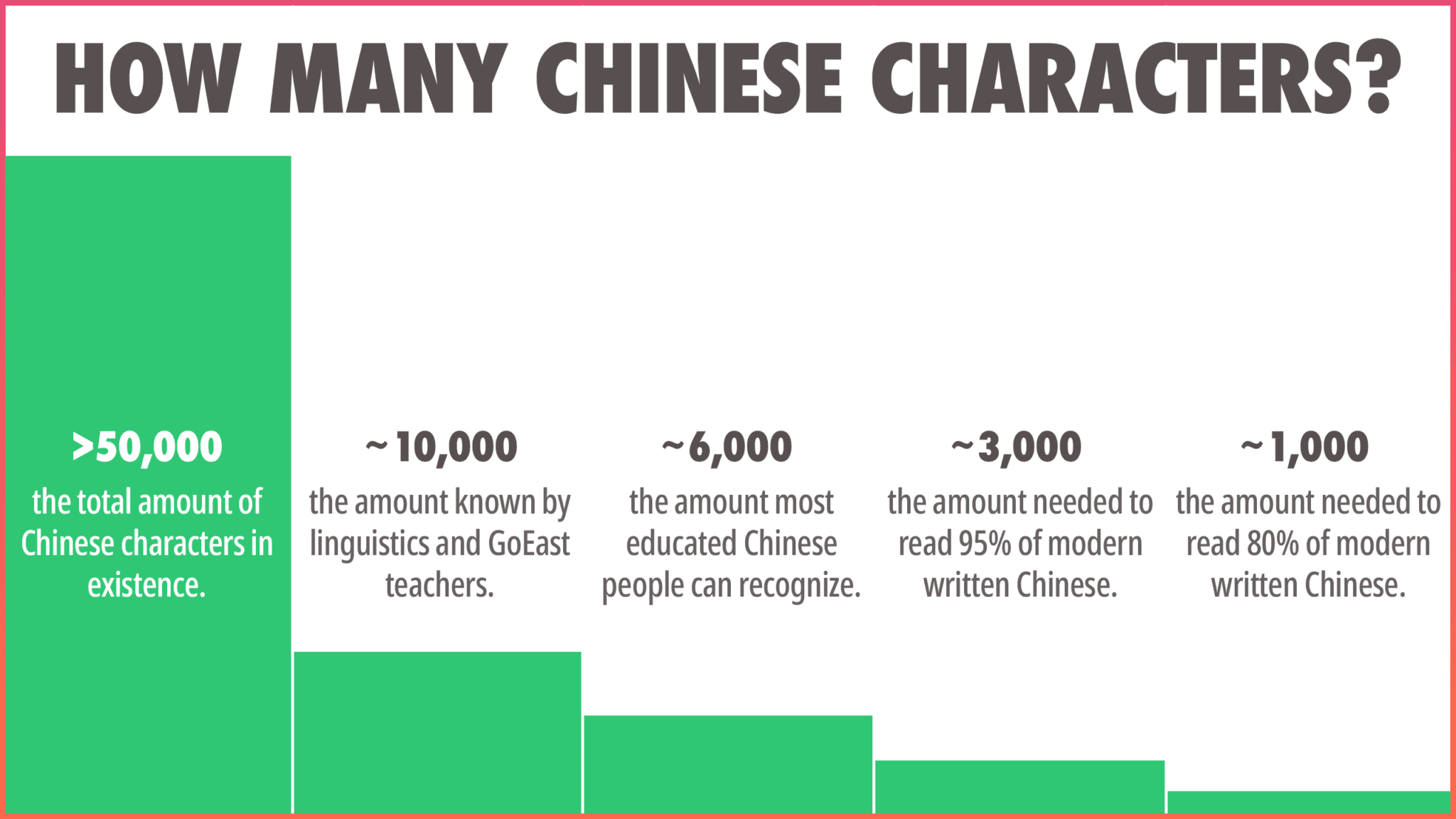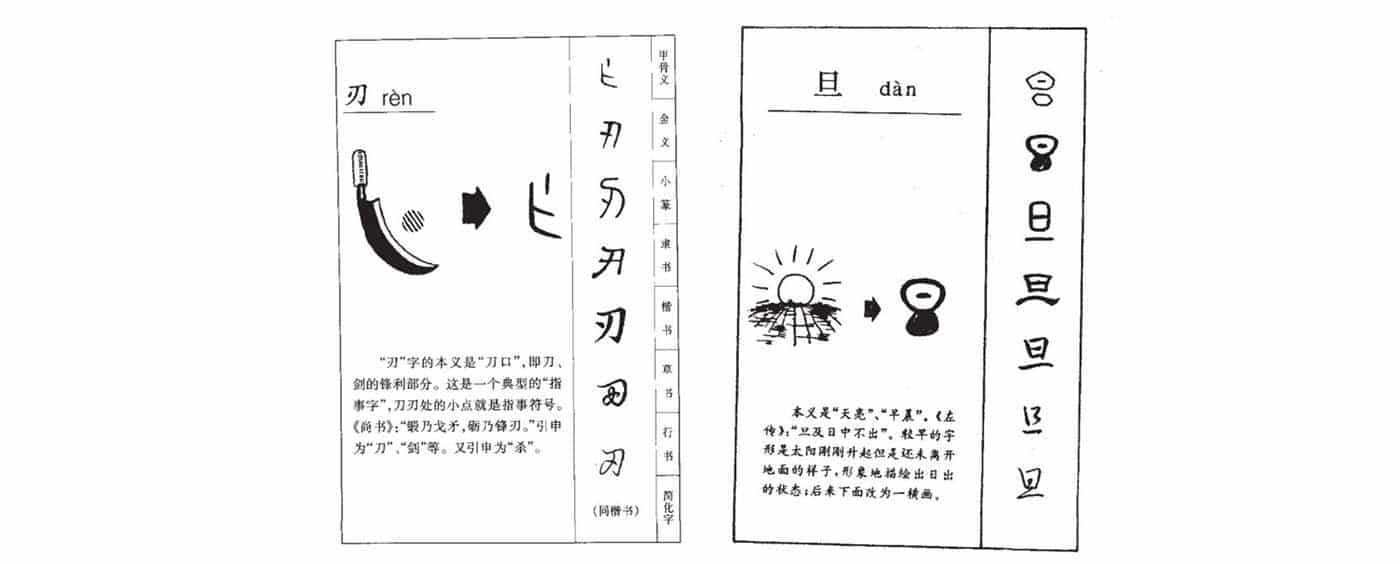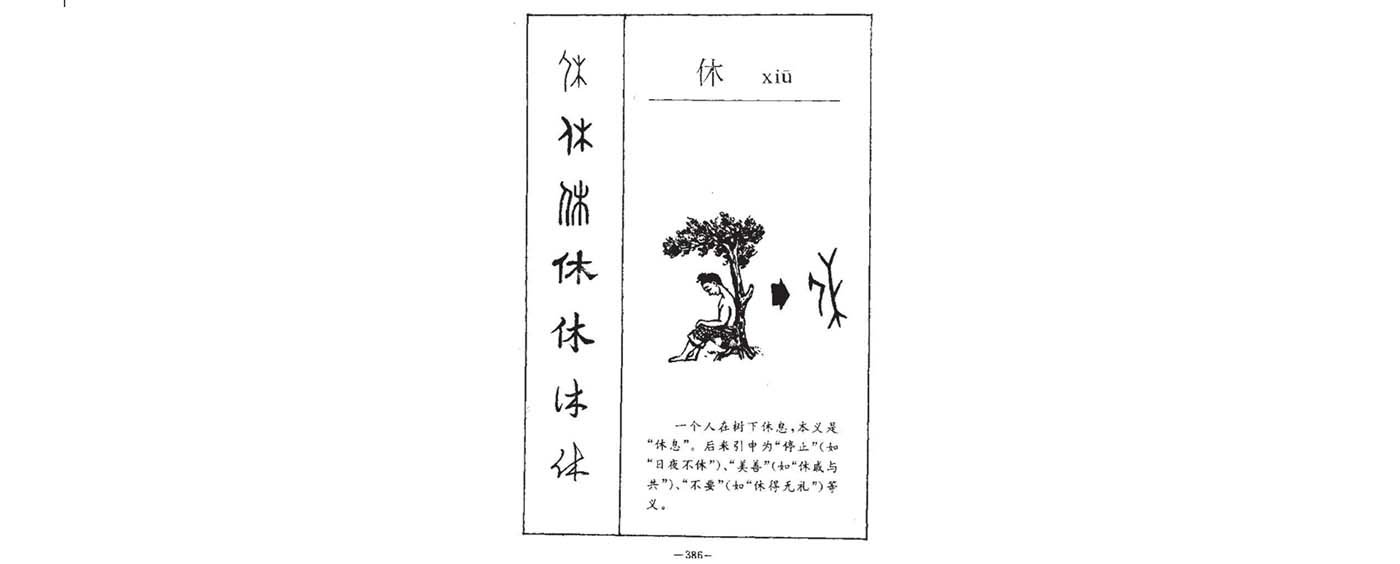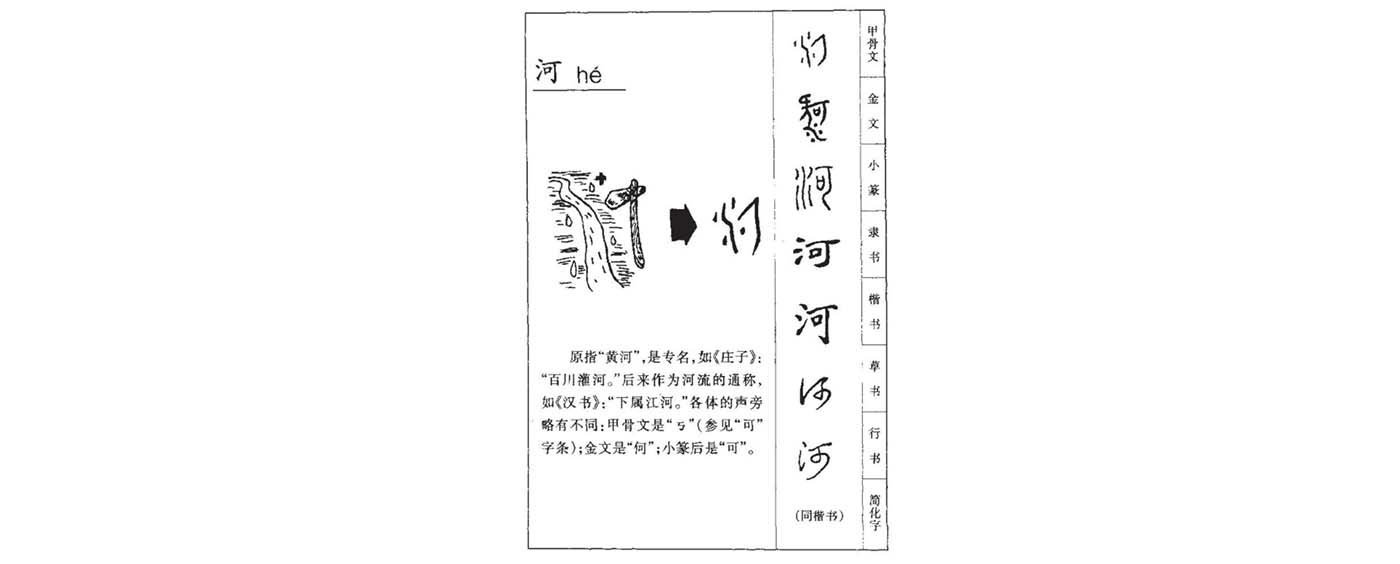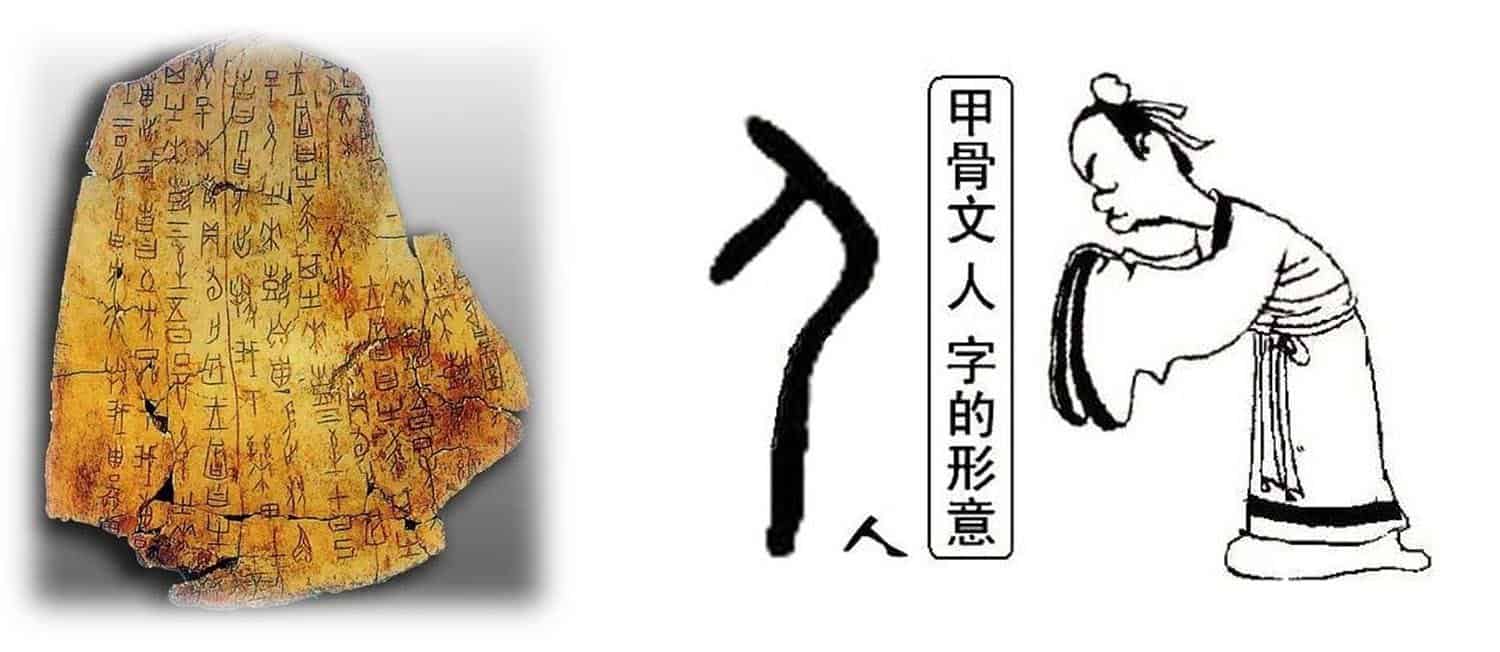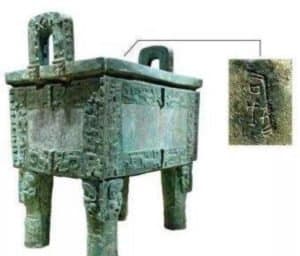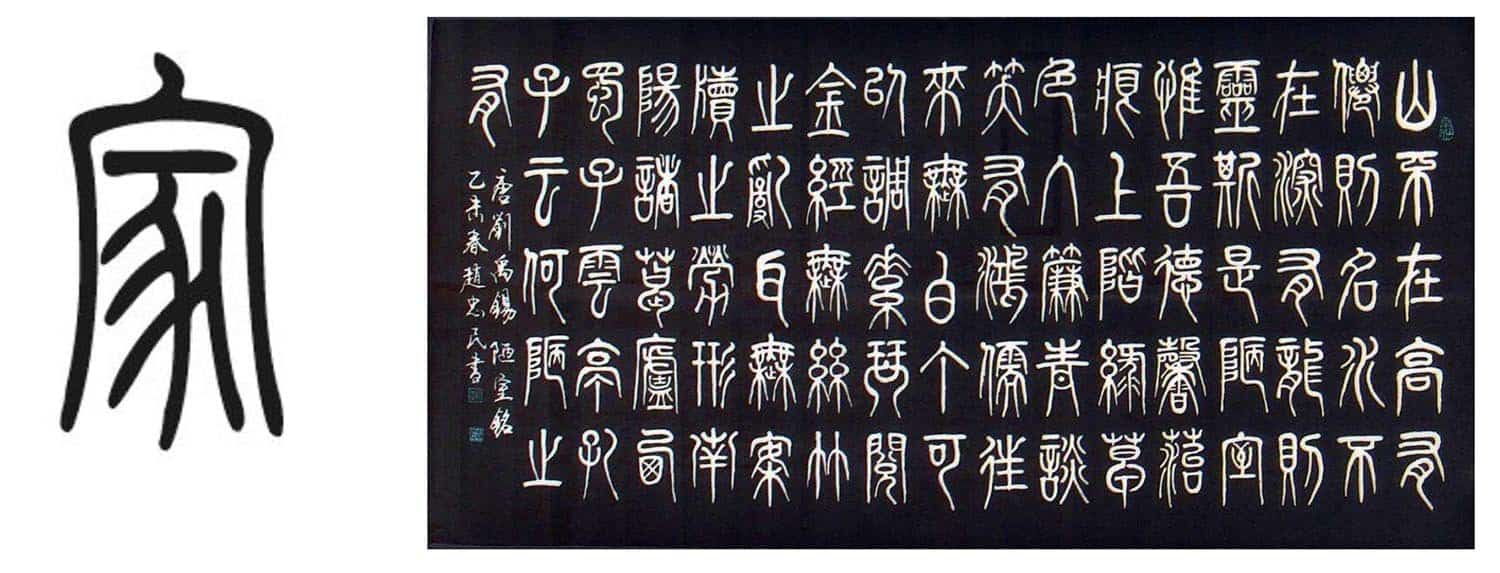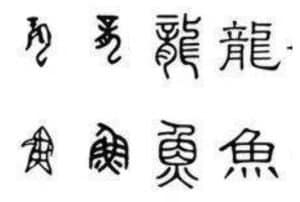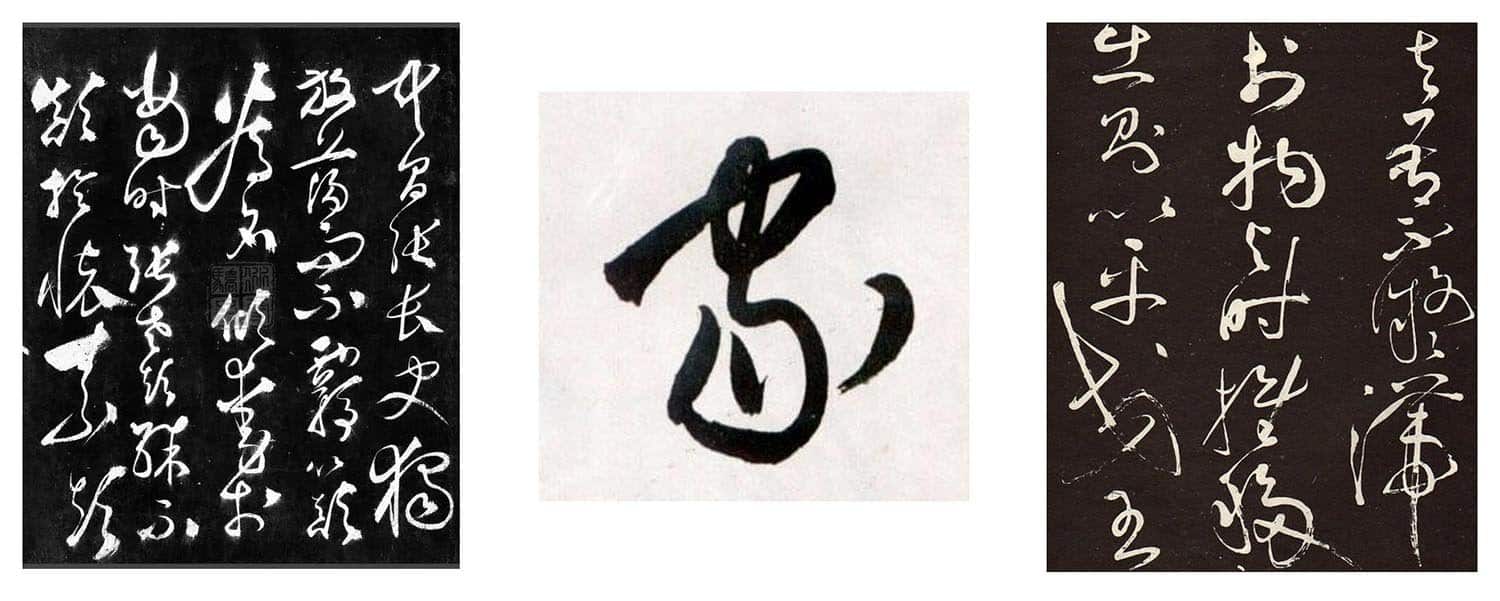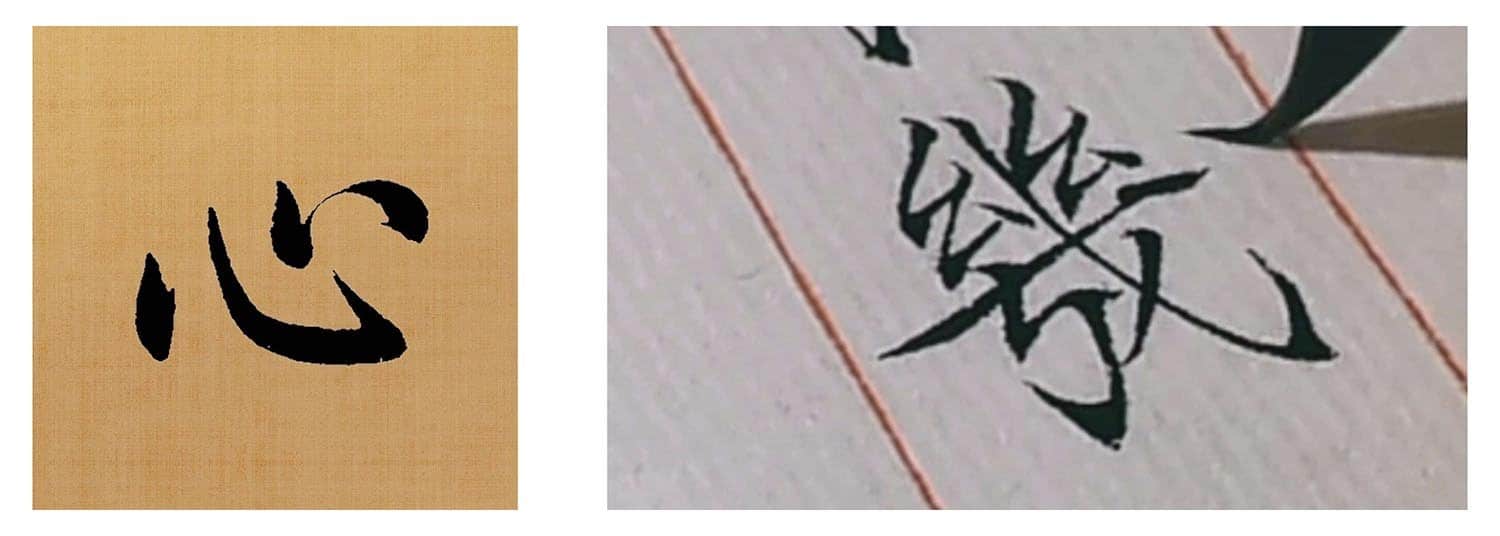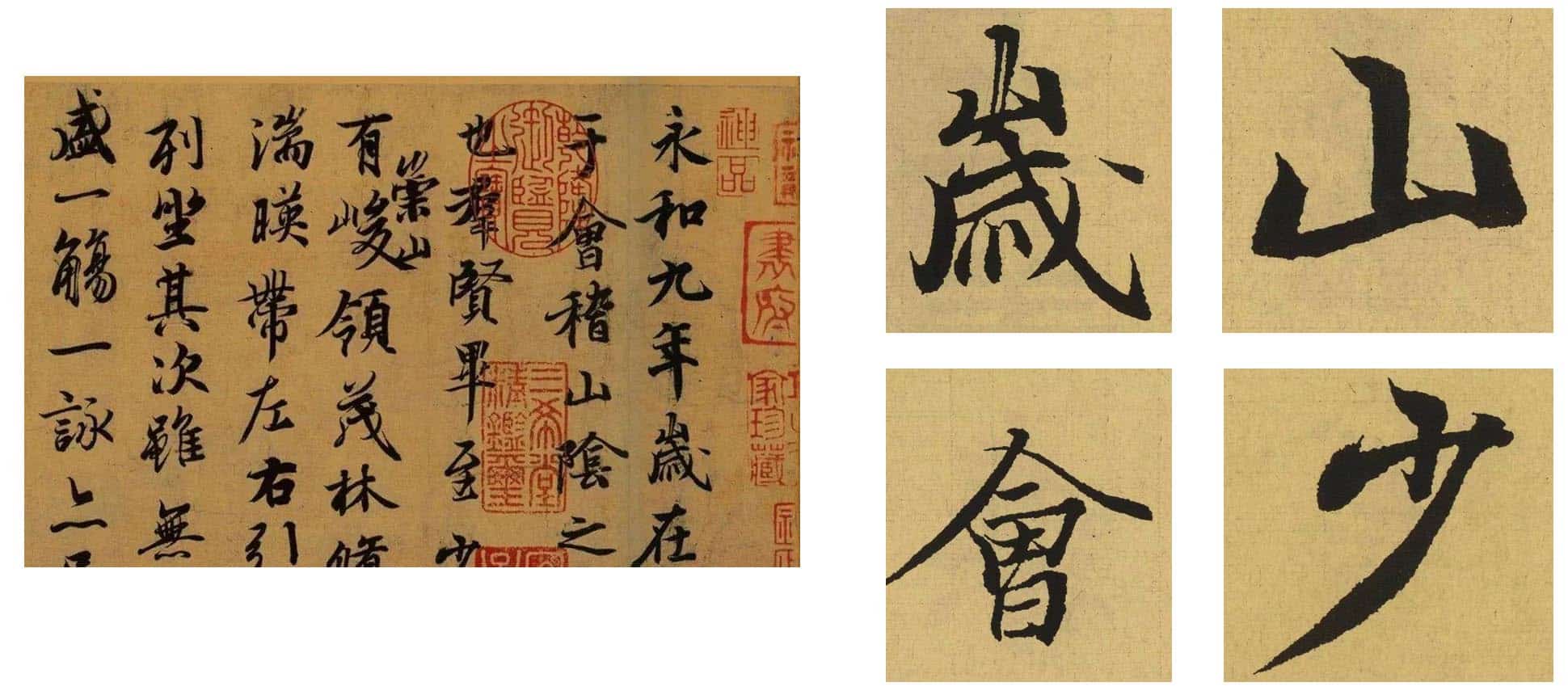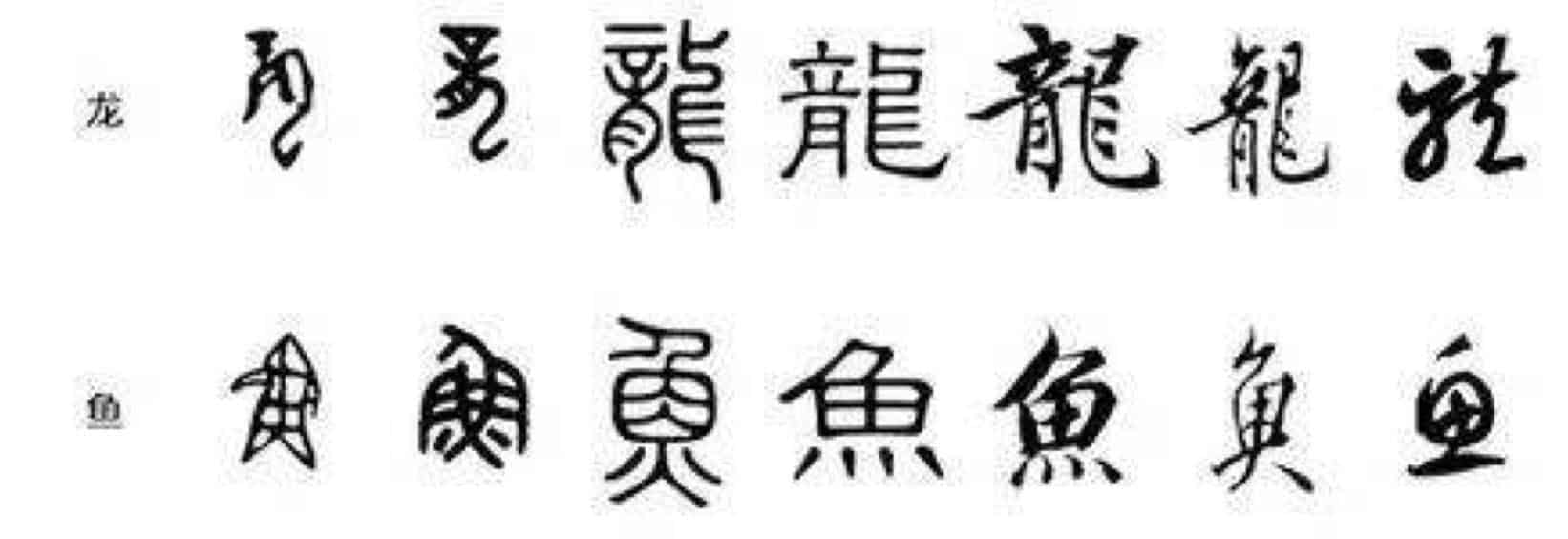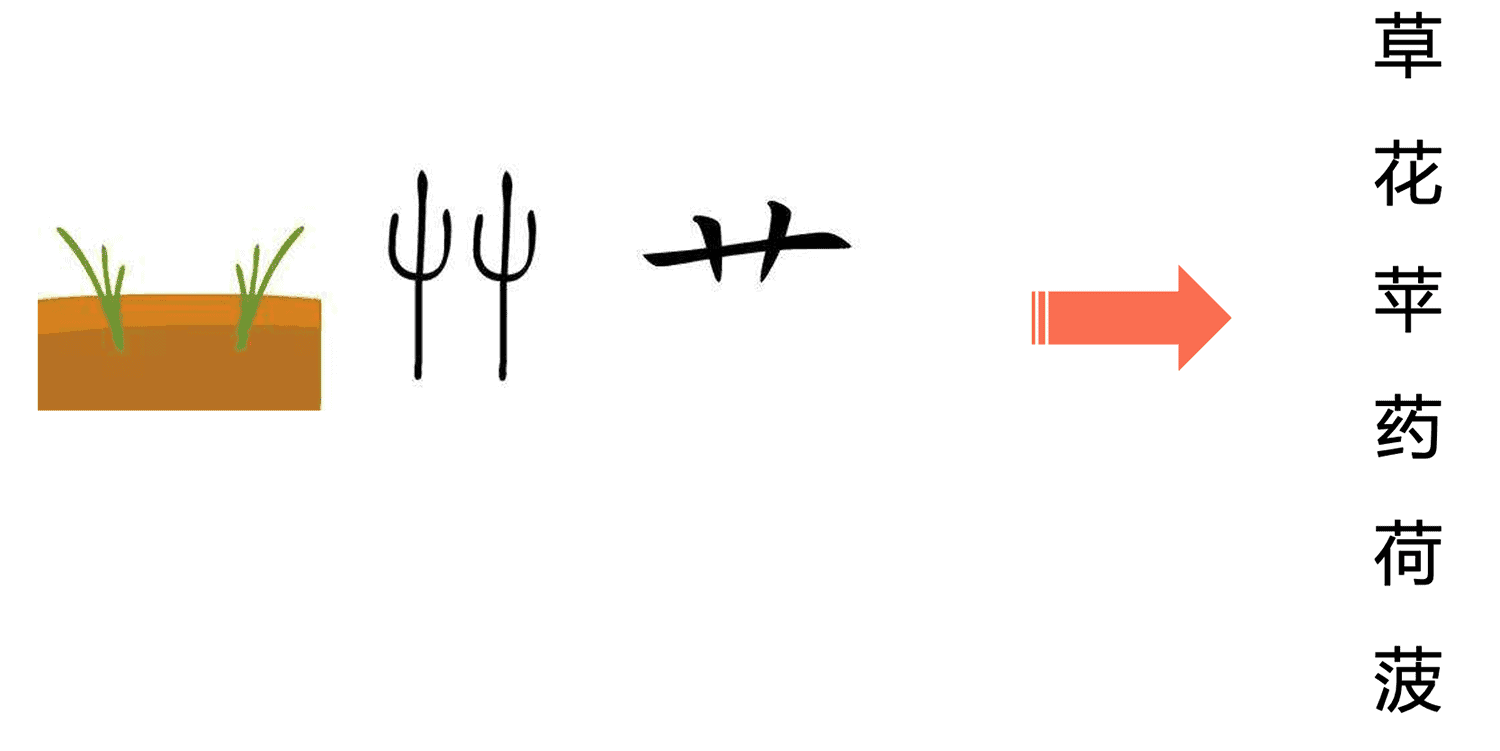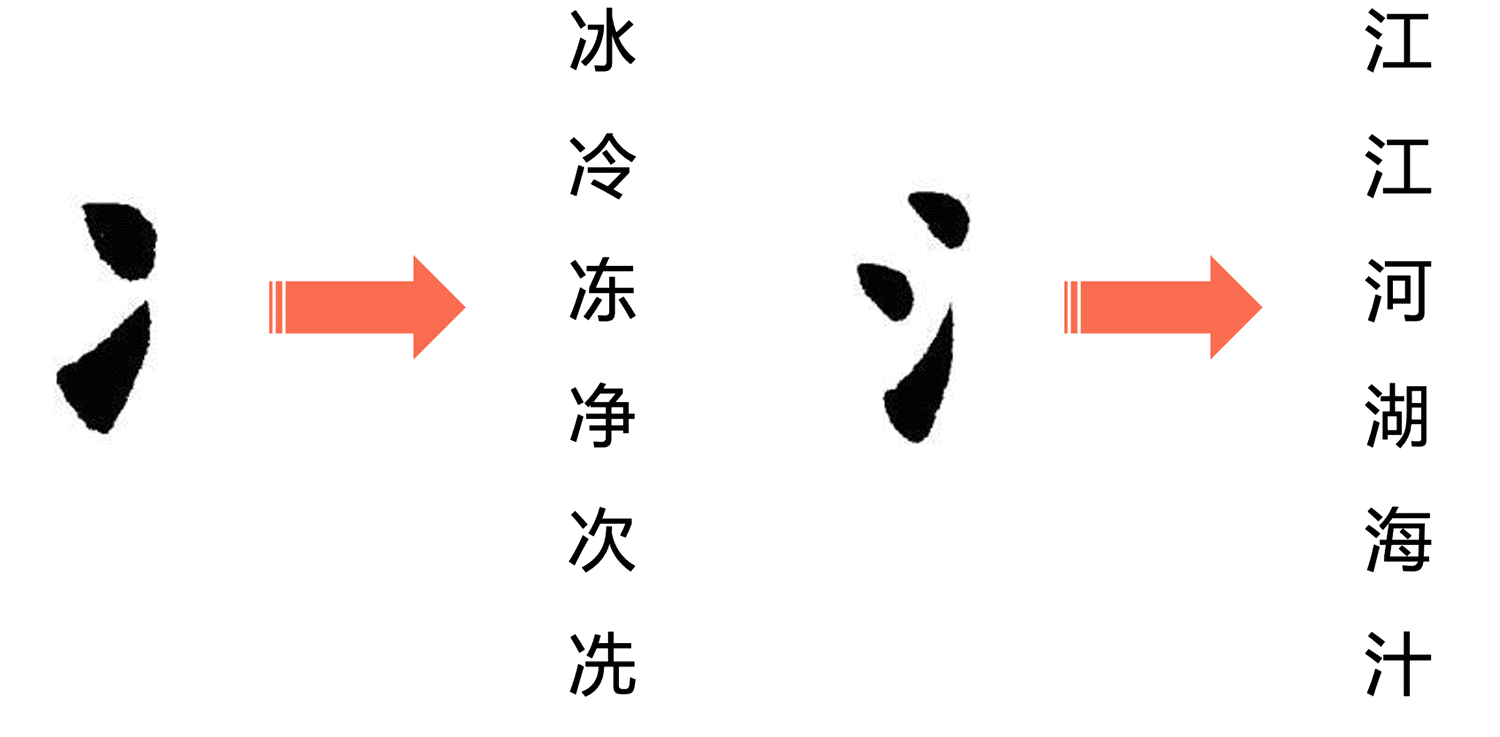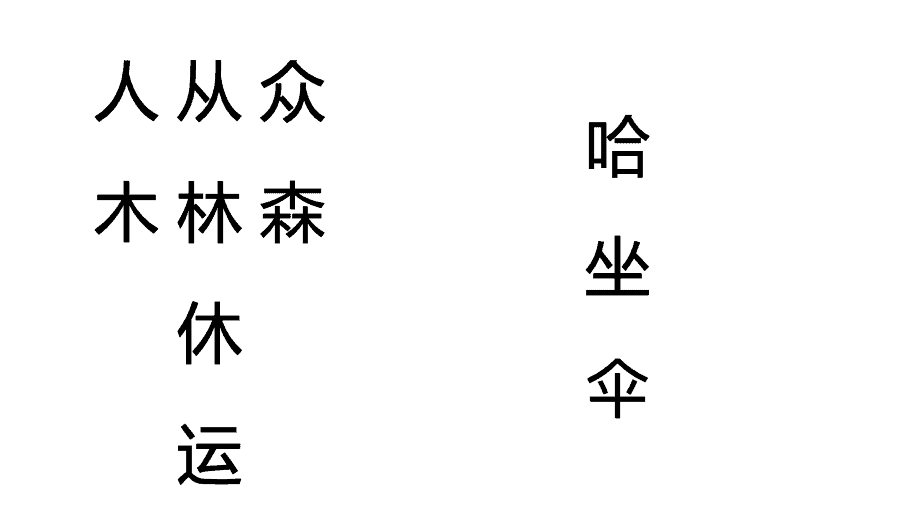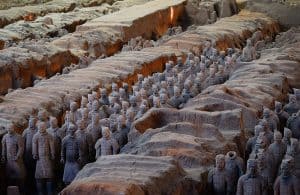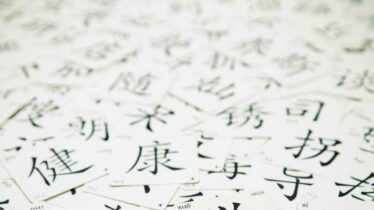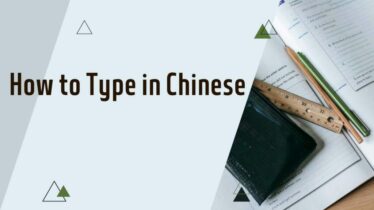Chinese Characters: Guide, Types, Count & Learning Tips
Hanzi, or Chinese characters, are easier to learn with the right study material and learning tips. Aside from learning them with GoEast’s Hanzi course, that is… Scroll down for the history, how to memorize and write Chinese characters.
How many Chinese characters are there?
Here’s a graph with some important numbers.
- >50,000 Hanzi characters is the total amount of Chinese characters in existence.
- But ~10,000 Chinese characters is the total amount of Hanzi a teacher at GoEast will know, or someone studying Chinese history, or linguistics or translators.
- And ~6,000 Chinese characters is the amount most normally educated Chinese people can recognize.
- The last two numbers are important for Mandarin learners:
- With ~3,000 Chinese characters you can read 95% of conventional Chinese written language.
- And with ~1,000 Chinese characters, you can read 80% of Chinese media.
The basics of Chinese characters
Despite their complexity, Chinese characters are not without rules. In ancient China, people used four types of characters: pictograms, referents, ideograms, and morphemes. We still roughly use these categories today.
Pictogram characters
Pictograms are based on the shape of an object and resemble pictures, so people know what they mean at a glance. For example, “日 (rì) ” is like a circle with a dot in the middle, like the shape of the sun when we look at it directly; “月 (yuè) ” is like the shape of a moon; “龟 (guī) ” is like the shape of a turtle on its side. The shape of a turtle.
Referents characters
These are a pictograph with one or two strokes added to it to indicate the meaning of the other character being illustrated. For example, “刃 (rèn) ” is a point added to the mouth of a knife to point out the edge of the knife;”旦 (dàn) ” is a cross under the sun, which indicates the horizon. The meaning of “旦” is the new day after the horizon rises.
Ideograms
characters are two different parts that create a new meaning. For example, in “休 (xiū) “, there is a person on the left and a tree on the right, and the person is resting on the tree, which means “休”.
Morpheme characters
The last type of character is a morpheme, which also has two parts, one of which represents the pronunciation of the character and the other part represents the meaning of the character, such as “河 (hé) “, where the left part means water and the right part represents the pronunciation of the character.
History of Chinese Hanzi characters
Chinese character are among the oldest characters in the world. According to legend, Chinese characters were invented by Cangjie around 5000 years ago. He was a bureaucrat under the legendary Yellow Emperor.Legend says that Cangjie had four eyes. He observed the footprints of birds and animals and was inspired to create words. It is said that when he created words, grain fell from the sky and the gods cried at night. This is called the Gǔyǔ (谷雨Gǔyǔ literally means ‘grain rain’). The gods worried that after people learned to write, they would go into business and give up farming, causing famine.
From there on, the history of characters can then be summarized into several periods.
5000 BC ~ 4000BC: Neolithic signs in China
In the 20th century, inscriptions were found on pottery on several locations in China, such as in Banpo near Xi’an. Because the signs are repeated over and over across several pots, this hints at the function of language. But the meaning of the characters is not entirely clear. Several historians see this as the predicessor of Chinese characters.
1600BC ~ 1046BC: The oracle bones (甲骨文Jiǎgǔwén)
Our later Chinese ancestors curved the character on tortoise-shell or bones, which is why we can still read it thousands of years later. These come from the Shang dynasty. These characters have a history of more than 3000 years, and they are quite mature in terms of form and character formation. They have literal meaning, they’re pictures, not standard characters, we can still recognize them! For instance, this character is a man standing. This is the predecessor of the Chinese character 人Rén (Person).
The oracle bones look like the Chinese characters we still use today: 日月水火土牛羊
~2BC: Chinese bronze inscriptions (金文Jīn wén)
The previous characters are all things we can see with our eyes, but how about the abstract meaning? These Chinese characters were added into bronze cups, bells and cauldrons. The characters evolved a bit.
~221 BC: Small seal script (小篆Xiǎo zhuàn)
But it’s really until the Qin emperor united China as one country and introduced small seal script characters for the whole country and agriculture. The big difference is that also abstract meanings were included in the Hanzi. They become characters rather than pictures. We can still very much recognize characters in this script, such as 家 on the left.
Evolution of Chinese characters
Here are three characters from the oracle bones (left), bronze inscriptions (middle) and small seal script (right). Here are the Chinese characters for 眉Méi: Eyebrow.
Chinese character style: Clerical script (隶书Lì shū)
From the Qin dynasty’s small seal script, this style of Chinese character writing came. It’s still very popular and both very readable and artistic thanks to being flat and fat. You still see it today as fonts on the computers, or in outdoor advertising. On the right, you see the character of 家 again.
Let’s compare these styles of Chinese characters: Here below are the signs of the Oracle bones (most left), Bronze inscriptions (center left), Small seal script (center right) and Clerical script (most right): On the top 龙 (dragon) and on the bottom 鱼 (fish).
Cursive script Chinese character style (草书Cǎo shū)
We think this style of Chinese characters belongs to crazy students! It’s very wild and creative, but very hard to read. When we at GoEast with our teachers talk about this style, we wonder if we can just write anything and say it’s a Cǎo shū character. Do you know the middle Chinese characters? We’ve repeated it many times in this article: 家.
Regular script Chinese characters (楷书Kǎi shū)
If the above is a crazy student, this is a good student. These characters are very clear and easy to read, and also popular today. On the left you see 心, on the right 几 but in its traditional form: 幾. Calligrafists often prefer traditional characters because they have more strokes compared to simplified characters. Simple characters are difficult to write beautifully.
Semi-cursive script Chinese characters (行书 Xíng shū)
And then we have semi-cursive script, a mixture of cursive and regular styles. This is our most favorite style. This piece below is the best piece of calligraphy in Chinese, and contains 323 words in Xíng shū characters.
Then we compare the characters once more, again 龙 and 鱼, from left to right: Oracle bones, bronze inscriptions, small seal script, clerical script, regular script, semi-cursive script, and cursive script.
Writing a Chinese Hanzi character
Unlike Pinyin, Chinese characters are arranged in a linear pattern, a box structure. Whether it has more strokes or fewer strokes, all strokes are written in the same big box.
Each Chinese character has two parts: radicals which assist meaning and pronunciation, and components which make a character distinctive. And each character has strokes. This character 汉 has 5 strokes! They are numbered 1 to 5, which is the order in which they should be written. Following the right order will make it easier for you to memorize Chinese characters and write them correctly.
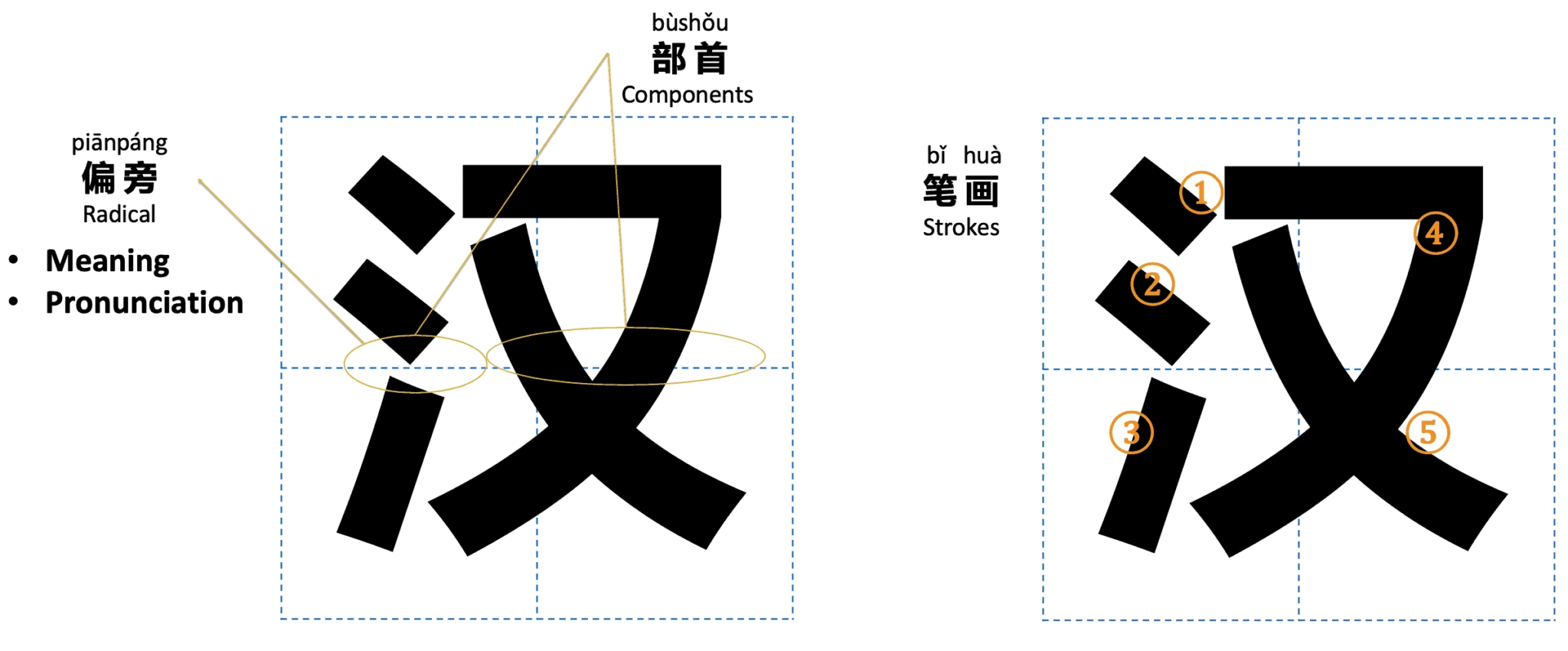
For example“语”:
Here are the radicals of 草 (grass), which is written on the top, with the part of the Chinese characters of grass, flower, apple, medicine, lotus, and spinach.
Here are the radicals for ice (left) and water (right), which look eerily alike. Chinese characters with the water radical are: ice, cold, freeze, clean, times, and Xian (name). For ice they are: river, lake, ocean, juice, and wash.
Then there are also Chinese characters that fit together or are still pictures. See here 从 (from) 众 (crowd),木 (wood) 林 (tree) 森 (forest) 休 (rest) 云 (cloud) 哈 (hah) 坐 (sit) 伞 (umbrella).
Traditional versus simplified characters
Read all about this in our article Simplified vs Traditional Chinese characters.
Some tips for writing Chinese characters
- A sharp pen (e.g. Uni-ball eye), it makes it easier to write clear Chinese characters
- Inside Pleco is stroke order, or download an app called ‘Chinese stroke order’
- Practice, practice, practice
- Join GoEast’s Hanzi course to learn Chinese characters!
Memorizing Chinese characters
Do Chinese characters always make you feel like grabbing your head and screaming for mom? It’s not necessary! Chinese characters are logical, and if you can figure out how the character comes from, you won’t forget! Memorization tips based on simplified Chinese characters can go a long way.
“取”and“娶”
Do you know Character “取”?Do you know the story behind this Character? About “取”, the left part is “耳” which means ear and the right part is “又”, it means human’s right hand rather than “again” in the very beginning. There is a horrible story about this Chinese character “取”. A long time ago, there was a king who wanted to encourage his soldiers to kill more enemies, and said the more enemies you kill, the greater reward you can get. But how do you prove how many enemies a soldier kills? There weren’t any smartphones around. Soldiers had to bring back one ear of enemy as evidence. So now we have the Chinese character “取”(taking the ear by hand), which means take and fetch. Of course, “取” can also be component of other Chinese characters. For example, “娶”, which consists of “取” and “女”, means to take your girl, which means to marry a girl.
“难”and“谁”
Now that you know that “又” means right hand. Perhaps the tips below will help you tell the difference between “难” and “谁”. These two words have the same component, “隹” (zhuī), it means a bird with a short tail and is often used in Chinese characters for pronunciation, but the pronunciation of Chinese characters has also changed a lot. “难” consists of “又”and“隹”. Can you imagine if catching a bird with your hands is easy or difficult? I think you get the answer. The radical of “谁“ is “言”(language ). If someone knocks at the door, of course we have to ask “who is there”.
“左”and“右”
Although “左” and “右” seem easy. But does recognizing “左” and “右” make you look at your left and right hand for a minute? We can use our left and right hands to work and eat, because those are the two things that are most important to us. In China, majority of people eat with their right hand, so the Chinese character for “右” is followed by a “口”(kǒu;mouth);the left hand can only work well, so the part of Chinese character for “左” is “工” from “工作”(work).
Except these, are you able to find your own effective and interesting tips for memorizing Chinese characters as well?
Click here to see more Chinese Hanzi Characters that look just like their meaning.
GoEast’s Video about Hanzi
Here’s Lynn in our live event, explaining Chinese Hanzi characters, all the way from its history to explaining radicals and components, as well as strokes. Learn more about Chinese history, culture, characters, and calligraphy styles. Chinese Hanzi characters aren’t as difficult as you think they are!
Read more:
What are basic Chinese characters?
Basic Chinese characters, also known as radicals, are the fundamental components that make up more complex characters. Some examples include numbers like 一 (one), 二 (two), 三 (three), and common words like 上 (up/on), 下 (down/under), and 中 (middle/center).
What is the most popular Chinese character?
According to various frequency lists, the character 的 is the most frequently used Chinese character across different regions and time periods. 的 is a grammatical particle used for forming possessive or descriptive constructions.
Who is the hardest Chinese character in the world?
The character 𧚒, with its incredible 172 strokes, is generally regarded as the most complex and difficult character in the Chinese writing system. However, it is shrouded in mystery, as scholars have tried to determine both its source and meaning, with some believing it is just a made-up or nonsense character.
Q4: Does Chinese or Japanese have more characters?Japanese has fewer characters than Chinese. The Dai Kan-Wa Jiten, a comprehensive Japanese dictionary, contains about 50,000 characters. In contrast, the Zhonghua Zihai, a Chinese dictionary published in 1994, contains about 85,000 characters, although many of them are obscure variants or archaic forms not in common use.
What are the 8 Chinese strokes?
The eight core brush strokes that make up all Chinese characters are:
- 点 diǎn (dot)
- 横 hèng (horizontal line)
- 竖 shù (vertical line)
- 钩 gōu (hook)
- 提 tí (tick)
- 撇 piě (sweep left)
- 捺 nà (sweep right)
- 折 zhé (turn)
How many Chinese characters do I need to know?
While there are over 80,000 Chinese characters in existence, a working knowledge of just 2,000-3,000 characters is considered a good foundation for literacy in Chinese. This relatively small set of characters equips the reader to understand approximately 97-99% of modern texts.

